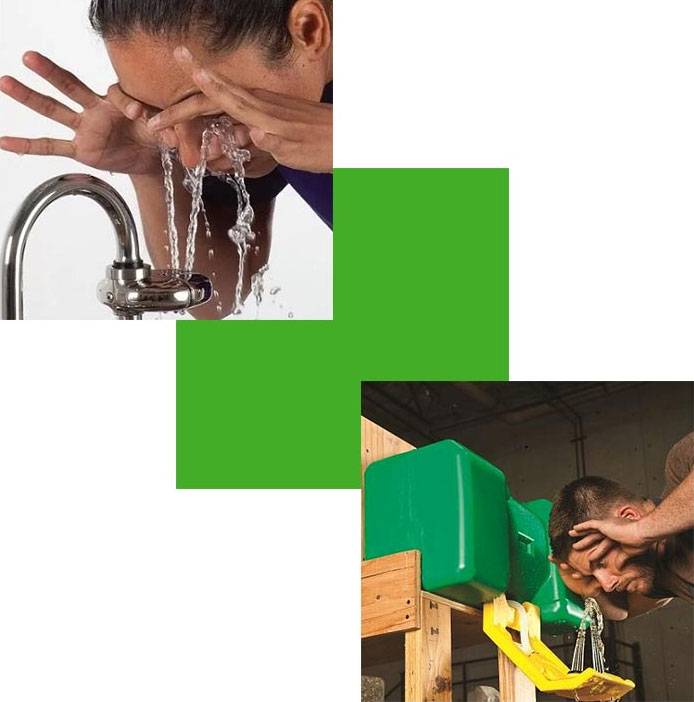Blogs
How to install a Workplace Safety Eyewash Station

Eye injury is a common yet highly preventable workplace safety concern for many Australian businesses.
The delicate human eye can easily become damaged from exposure to corrosive chemicals, fumes, allergens, dust and debris.
While proper procedures and PPE protect the eyes from contact with eye-irritating contaminants, it is essential when managing occupational health and safety workplaces prepare an immediate eye injury response.
One of the best supports for an injured eye is a well-placed eyewash station.
The expert team at iQSafety have put together this handy guide to installing an emergency decontamination eyewash station to comply with Australian Safety Standard AS4775-2007 - Emergency eyewash and shower equipment.
Do I Need An Eyewash Station?
While every business can benefit from installing an eyewash station as a precautionary first-aid measure, the safety controls and compliance requirement to do so will depend on your business processes and the dynamics of your workplace.
To determine whether your business' current eye safety control measures are sufficient and adequate, you should consider the following:
- 1. Have you conducted a workplace eye injury risk assessment? A risk assessment helps identify and assess the chemicals, hazards and work processes most likely to expose your workers to an eye injury.
- 2.Do you have Safe Work Procedures (SWPs) documented and in practice for every task that carries a potential risk of eye injury? While an eyewash station is an instrumental piece of emergency first aid equipment, it won't prevent an accident. To protect workers from chemical contact, fumes or flying debris, you must have appropriate risk control measures in place, such as isolation devices and personal protective equipment (PPE).
- 3. Have you attempted to eliminate or reduce identified hazards? Prevention is by far better than cure if you can remove the potential source of an eye injury that should be your priority in your WHS efforts.
- 4. Have any recent changes or events in the workplace occurred that could warrant new (or expanded) emergency decontamination eyewash facilities? Such as:
- New hazardous substances: whenever new chemicals and Dangerous Goods enter the workplace, existing decontamination equipment and protocols require evaluation. Referring to Material Safety Data Sheets (MSDS) will provide hazard class information and first aid recommendations. For example: introducing Class 8 corrosive chemicals for disinfecting frequently touched surfaces as part of your COVID-Safe Plan to minimise the risk of coronavirus transmission in your workplace
- Production output increases: The larger and more complex your business becomes, the greater the chance you will increase the quantity and variety of hazardous chemicals, and Dangerous Goods kept onsite. Workers may also be exposed to chemicals for extended periods, or there may be more work areas or equipment where staff could potentially sustain an eye injury.
- Workforce expansion: As your staff numbers grow the risk of eye injury increases leading to a greater likelihood of needing one or multiple eyewash stations depending on risk.
- Renovations and construction work: During these events, your workspace may experience increased eye health risks from dust and airborne debris as well as possible irritation from solvents and paints. Another important consideration is whether access to existing workplace emergency decontamination facilities may be impacted or obstructed during or after renovations or construction work.
- New equipment and machinery: Every new piece of equipment or machinery introduced to your business requires assessment for risks and hazards, such as whether an operator is at increased risk of exposure to dust, flying particles, chemical contact, fumes, splashes, sparks, flashes or burns.
- An accident, incident, or near-miss has occurred: Following a workplace incident investigation, you may determine the need for new or improved or increased decontamination facilities.
- An independent audit or inspection has determined the need to install an eyewash station: WorkSafe Australia and independent consultants and safety auditors who specialise in Dangerous Goods can inspect your workplace. Using their knowledge of hazardous chemicals across a range of industries, they can identify potential hazards and limitations of your existing SWPs and decontamination equipment that you may have overlooked. They will also help you appraise the adequacy of existing or proposed eyewash installations.
Selecting and Installing Emergency Eyewash Facilities
Once you've identified that your workplace needs an eyewash station, you'll need to choose a unit that will best serve the type of hazard and the area or number of workers it will service.

Types of Eyewash Units
Eyewash stations come in a range of styles and options with specific units being better suited to different needs and areas. They should allow the user to flush both eyes simultaneously with water or saline solution at low pressure for at least 15 minutes.
- Personal Emergency Eyewash Stations - These quick access bottle units are wall-mounted so don't require plumbing. Positioned virtually anywhere to ensure the station is accessible within 10 seconds of a hazard, in compliance with Australian Standard AS4775-2007. The dual eyewash streams allow both eyes to be treated at once, neutralising acid and alkali substances and restoring proper pH balance to eyes.
- Tap Mounted Eyewash - Units such as the Axion eyePOD® are an innovative emergency eyewash solution designed to convert a plumbed standard faucet into an eyewash station.
- Portable Gravity-Fed Eyewash Station - Designed to offer a gravity-fed flush, so no plumbing or water supply is needed makes these units perfect for large warehouses & factories where access to plumbed eyewash stations is limited.
- Floor or Wall Mounted Eye & Facewash Station - These units combine an eyewash & facewash facility and mount to floor or wall plumbing outlets. These are a more permanent quick access solution to protect your staff from eye contamination when working in industrial, manufacturing or laboratory areas.
Choosing suitable locations for your emergency decontamination eyewash stations
Depending on your work areas and workforce size the number and positioning of eyewash stations will vary but to comply with Australian Safety Standard AS4775-2007 - Emergency eyewash and shower equipment, the location of eyewash stations should take into consideration the following:
Accessibility
Emergency eyewash stations must be easily and immediately accessible and located on the same level as the hazard. An injured worker may have impaired vision, so the pathway to an eyewash station must have no obstructions. The worker cannot be required to use a ladder or stairs; unlock or open cupboards, doors, or gates; navigate obstacles, partitions or barriers; or move items. Eyewash stations should be located near exits so emergency responders can easily reach the injured person. Do not position eyewash stations where further contamination could occur.
Convenience
An injured worker must be able to access an eyewash station within 10 seconds of the injury occurring. When deciding where to locate decontamination facilities, consider where potential injuries are most likely to happen in your workplace. If you have a collapsed worker requiring decontamination, would they need to be carried to a fixed eyewash station by co-workers? If so, that could slow down accessibility time. To comply with the 10 seconds from injury rule, you may need to consider a backup emergency hand-held eyewash unit.
Visibility
Given an injured worker may have impaired vision the visibility of a safety eyewash station can impact the 10 seconds from injury rule. All units are required to be highly visible, marked with a compliant warning placard and the entire area serviced by the station must be well lit.
Hazardous material type
Australian Standards set the requirements for the location of emergency decontamination facilities based on the chemical or Dangerous Goods class that could potentially cause eye injury.
For example, AS3780-2008 - Class 8 corrosive chemicals requires a decontamination shower and eyewash unit within 7-10 metres of corrosive substances, yet no closer than 2 metres. Other considerations include how water from decontamination equipment could potentially react with nearby chemicals, or if the substances flushed could contaminate or degrade your facilities.
To find Dangerous Goods class-specific requirements, see:
- AS1940-2017 Class 3 - Flammable liquids
- AS5026-2012 Class 4 - Flammable Solids
- AS4326-2008 Class 5.1 - Oxidising substances
- AS2714-2008 Class 5.2 - Organic Peroxides
- AS4452-1997 Class 6.1 - Toxic substances
- AS3780-2008 Class 8 - Corrosive substances
Workplace or job site
The final factors for choosing where to install your emergency eyewash stations will come down to what type of business you run, the types of workers and contractors that may be at risk and the nature of the work undertaken. When choosing the location for your decontamination eyewash equipment, you should consider:
- Drainage: Where will contaminated wastewater be disposed? Have you put in place safeguards to ensure another worker or emergency responder can't sustain an injury from contact with contaminated wastewater, or that it won't flow into drains or waterways where it could harm the environment?
- Worker to eyewash station ratio: Is there a risk that multiple workers could become injured at the same time? If so, do you have adequate units in place for them all to access within 10 seconds of injury?
- Electrical hazards: while using an eyewash facility, is there a potential flushing fluid could come in contact with electrical cords or equipment causing an electrocution hazard?
- Temperature: Eyewash water temperature should be comfortable, generally between 15 and 37°c. Any hotter and water can facilitate chemical reactions, causing more damage to the eyes. Any colder and water causes discomfort, leading to injured workers not flushing their eyes for the full 15 minutes. Also, if an eyewash station is open to the elements, it is crucial that pipes don't freeze or can't heat up in the sun and become unsafe for flushing.
- Disabled workers: are your eyewash facilities accessible to disabled workers who may need to access it from a wheelchair?
- Privacy: in the urgency of a chemical emergency, an injured worker may have to remove contaminated clothing quickly. Wherever possible set up decontamination facilities in an easy to access yet low traffic area.
- Employee Training: most eyewash stations are pretty self-explanatory and straightforward to use; however, it is still important that when undertaking OHS training, your employees learn how and when to use an eyewash station. Include regular practice emergency drills for all potential workplace eye injury hazards to make sure everyone knows where the closest eyewash station is with their eyes closed and can access and operate it within 10 seconds of a simulated potential injury.
- Practicality: Given the need for immediate first aid when an accident results in eye injury, positioning your eyewash unit near building exits makes it easier and faster for emergency responders, ambulances, or rescue vehicles to assist an injured worker.
Even in the most careful workplaces with every precaution in place to try to protect employees from eye hazards, occasionally accidents can and do happen, making eyewash stations a necessity.
iQSafety have a range of exceptional quality eyewash station solutions. Give one of our friendly specialists a call to discuss your workplace safety needs.




.jpeg)